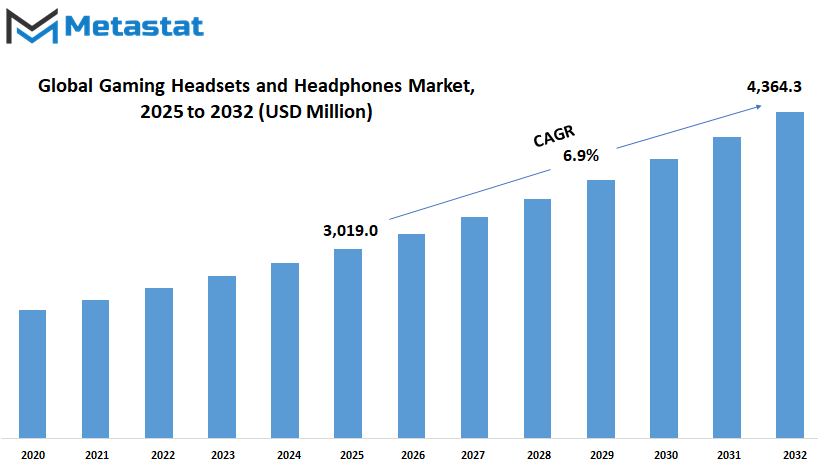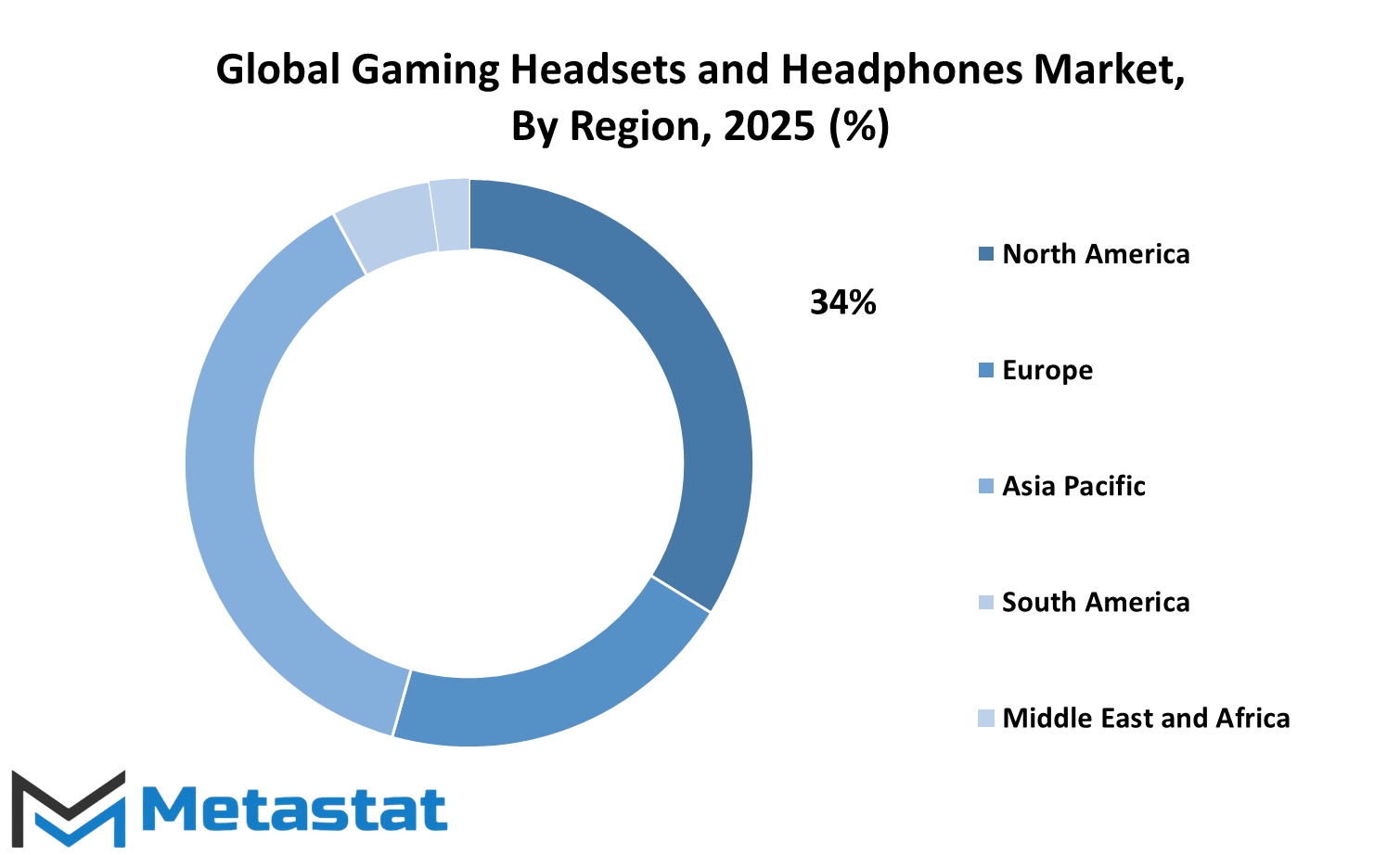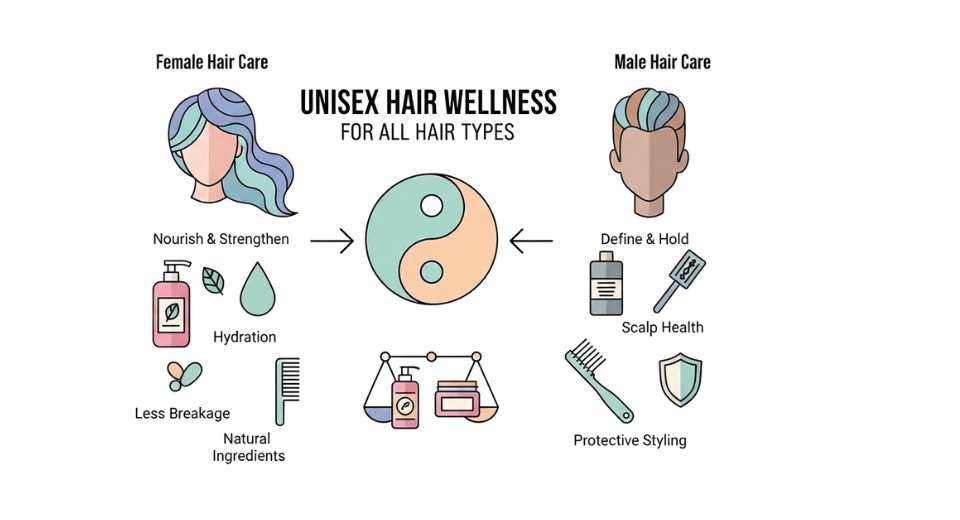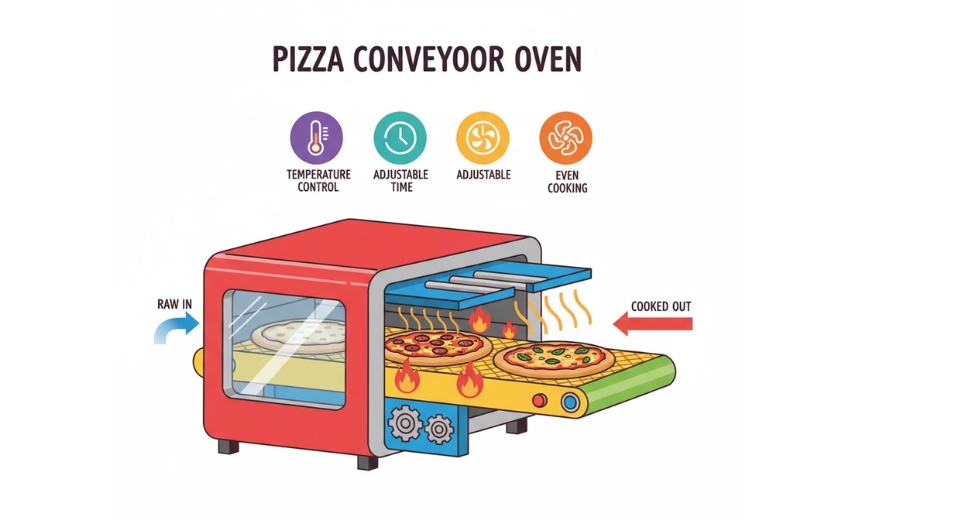MARKET OVERVIEW
The global gaming headsets and headphones market, as part of the consumer electronics and interactive entertainment sector, will establish a targeted segment that responds directly to user needs for surround-sound audio experiences in digital gaming worlds. This market will consolidate dedicated audio gear that responds to real-time communication, accurate sound localization, and high-fidelity playback demands of casual and professional gamers on consoles, PCs, and mobile devices.
As gaming culture grows through broader geographies and demographics, the global gaming headsets and headphones market will shift to serve the individualized acoustic and ergonomic requirements of its consumers. This market will not only serve the utilitarian purpose of sound delivery but also more and more incorporate aspects of fashion, comfort, and longevity. It will span wired and wireless, over-ear and in-ear form factors, and deliver options like noise isolation, spatial audio, and built-in microphones. The territory will also expand into voice-assistant support and cross-platform compatibility, echoing the lifestyle-based uptake of gaming as both amateur and professional activity. The global gaming headsets and headphones market will comprise hardware products from both established audio companies and new gaming-specific companies. It will not only encompass the manufacturing and sale of headsets and headphones but also related services like product customization, post-sales support, and audio control-enhancing software integration and firmware upgrades. It will range across retail and online channels, supporting both consumer-direct approaches and third-party collaborations.
Regional trends will shape design preferences, connectivity standards, and brand positioning in the global gaming headsets and headphones market. While North America and East Asia will remain major centers of consumption, increasing activity in South America, Eastern Europe, and the Middle East will increasingly expand the geographical scope of the market. The market will also overlap with sub-industries like esports, game streaming, and virtual collaboration tools, each having specific audio solutions that provide clarity, latency reduction, and longer wear comfort. Changes in technology in audio processing, Bluetooth transmission, and battery life will drive the functional expectations involved with the global gaming headsets and headphones market. Market players will have to synchronize their products with changing audio codecs, platform firmware, and multi-device synchronization features in order to keep pace with usage patterns that gravitate toward seamless cross-platform interaction.
User-driven feedback will increasingly play a role in the development process, with a keen emphasis on frequency response calibration and microphone clarity to meet both gameplay and content creation requirements. In aggregate, the global gaming headsets and headphones market will create a place where technology, design, and user experience blend in response to the complex needs of interactive entertainment. By grounding itself in the relationship between sound innovation and user-oriented design, this market will continue to reimagine the way audio is consumed within digital play and social interaction.
Global gaming headsets and headphones market is estimated to reach $4,364.3 Million by 2032; growing at a CAGR of 6.9% from 2025 to 2032.

GROWTH FACTORS
The global gaming headsets and headphones market is likely to experience significant growth in the future years. This growth will primarily be fueled by the rising popularity of gaming as a mainstream source of entertainment. More individuals are spending time gaming, not just for entertainment but as a means of socializing.
Online multiplayer games require effective communication, and good audio quality enhances the experience. Here is where gaming headsets and headphones become critical, enhancing the demand further. Also, the increase in esports and live-streaming sites is prompting more consumers to spend money on high-quality sound equipment, further driving the market. A further top reason why the global gaming headsets and headphones market is growing is the increased adoption of cutting-edge technology. With games continually getting better in graphics and audio design, gamers seek equipment that keeps up with the overall gaming experience. Designers are designing devices that provide surround sound, noise cancellation, and improved microphones. These features appeal to users in need of comfort and performance.
The availability of wireless headsets is also on the rise, providing flexibility and mobility, which appeals to a large group of gamers. Still, there are certain issues which may hinder this growth. One such issue is the expensive price of quality headsets. Not all could buy high-end products, which may restrict access among a segment of users. In certain countries, lower awareness regarding the advantages of these headsets may also restrain the market. Users might not always be aware of how good a headset could make their gaming experience, resulting in lower adoption. Nevertheless, the prospects of the global gaming headsets and headphones market are bright. With technology growing cheaper and more accessible, even more users will be upgrading equipment. In addition, increasing interest in virtual and augmented reality may develop new audio device innovations. These sectors require even higher quality sound and voice interaction in real time, and this will prompt companies to come up with better equipment. In the future, the market will have a good likelihood of growing as a result of these developments. New companies may join the market, and current businesses could try to make their products more affordable without reducing features. With increased attention placed on user comfort, sound accuracy, and wireless technology, the market will be propelled forward and become an even larger contributor to the overall gaming market.
MARKET SEGMENTATION
By Type
The global gaming headsets and headphones market will continue to see steady interest as technology shapes how people play, connect, and compete in gaming. In the future, sound quality will not just be a feature it will be a deciding factor in performance, enjoyment, and immersion. This market includes different types of audio gear, each suited to specific needs and styles. Over-Ear Headsets are likely to stay popular among serious gamers due to their comfort and ability to block out noise. These larger headphones cover the ear completely, making them ideal for long sessions. On-Ear Headsets, which rest on the ears instead of around them, offer a lighter alternative for casual play, while still providing clear audio. Then there are In-Ear Headphones, which have grown in popularity thanks to their portability and minimal design. They may become more common as wireless technology improves, and gamers look for more freedom of movement.
Gaming is no longer just about visuals. Players demand clear communication, accurate directional sound, and deep bass that enhances in-game action. As developers create more detailed environments and lifelike effects, gamers want headsets that can match that experience. Future devices will likely feature smarter sound settings that adjust automatically based on the game being played or the type of gameplay. Voice pickup will also improve, helping players talk to teammates without needing to shout or repeat themselves. Microphones may become more discreet, possibly built into the headband or earcup without sacrificing quality.
This market will also benefit from the rise of virtual and augmented reality. These technologies need audio tools that are responsive and can follow the user’s movements. Over-Ear and In-Ear designs will be adapted for these needs, making the listening experience feel more real. Wireless charging, longer battery life, and lighter materials are also likely to become standard, helping gamers focus on play without being distracted by gear problems.
The global gaming headsets and headphones market will keep growing not just from gaming itself, but from how people use this equipment for streaming, content creation, and even casual listening. As hardware improves and becomes more affordable, more users will expect professional-grade performance at home. In this way, sound will stay at the heart of how players interact, respond, and enjoy the games of tomorrow.
By Connectivity
The global gaming headsets and headphones market is gradually attracting more attention with technology playing a greater role in how individuals play and engage with digital games. With games becoming more sophisticated both visually and aurally, the need for improved audio gear necessarily increases. No longer do players accept ordinary sound quality. They want to be able to hear every step, every breath, and every hint that can make all the difference. This increasing interest is determining the way the gaming accessories market develops, and headsets and headphones are outstanding components of the experience.
Looking to the future, it is obvious that audio equipment designed to be used for gaming will be further specialized. These are not ordinary headphones with higher volume; they are designed to make gaming better through precision, comfort, and good communication. The international Gaming Headsets and Headphones market demonstrates an increasing emphasis on sound quality and immersive capabilities. Gamers anticipate more than fundamental functionality they desire comfort for marathon gaming, noise-canceling capabilities, and clear, non-disconnecting microphones for multiplayer sessions.
Connectivity is among the most powerful forces driving purchasing decisions. The industry is divided between the wired and wireless camps, each holding its own advantages. Wired models tend to appeal to users concerned about quick response and being constantly connected. They do not require batteries and typically cost less. Wireless models provide mobility, which is increasingly valued as gaming environments extend away from plain desk space. As wireless technology continues to advance, including battery duration and stability of signal, more consumers might transition that way.
In the future, we could expect smart features to be a standard component of game audio equipment. Voice recognition, sound control based on the environment, and automatic adjustments to audio could become more prominent. As games incorporate increasingly sophisticated sound layers, these headsets could adjust in real time to provide the most appropriate audio experience. There is also a big movement toward lighter products and eco-friendly materials, evidencing that producers are being responsive to user feedback and environmental issues.
The global gaming headsets and headphones market will continue to expand, influenced by evolving user demands and quick technology advancements. Gamers desire sound performance equal to the look of their favored games, and this demand is driving producers to plan ahead and remain innovative.
By Platform Compatibility
The global gaming headsets and headphones market is showing strong signs of growth as gaming becomes more mainstream across the world. With the rise in popularity of online games, competitive esports, and immersive storytelling experiences, there is a growing demand for devices that deliver high-quality sound. Players want to hear every detail, from the faintest footsteps to explosive battle sounds. This growing interest is pushing developers to create products that not only improve audio clarity but also enhance comfort and usability over longer gaming sessions.
As the market continues to grow, platform compatibility is playing a major role in how products are developed. Today, the market is being shaped around three main platforms: PC, console, and mobile. Each of these categories brings its own set of needs and expectations. Gamers on PC often look for advanced sound customization, features that allow for clear team communication, and a solid build for daily use. On the other hand, console players using systems like PlayStation, Xbox, or Nintendo tend to seek seamless plug-and-play experiences, often preferring wireless headsets for added freedom. Meanwhile, mobile gamers prioritize compact designs, lightweight features, and strong battery life since they are more likely to play on the go.
This shift towards catering to platform-specific needs has influenced product design in new and creative ways. Brands are focusing on headsets and headphones that can switch between devices without the user having to go through technical steps. There is also a rise in interest in voice clarity, especially with the rise of multiplayer games that require strong teamwork. Features like noise cancellation, detachable microphones, and audio balance control are no longer viewed as luxury options but rather expected standards.
Looking ahead, the global gaming headsets and headphones market will likely see more smart features, such as voice assistants or touch controls, making their way into standard models. Battery life, Bluetooth range, and compatibility with upcoming consoles and mobile devices will all be key areas for innovation. As the gaming audience becomes more diverse, from casual mobile users to serious esports competitors, companies will continue to adjust their designs to meet shifting expectations. With gaming turning into a part of daily life for many people, this market is expected to remain dynamic and full of possibilities for growth and improvement.
By End-User
The global gaming headsets and headphones market will continue to grow as the demand for more immersive and engaging experiences becomes stronger. With technology constantly improving, gamers are expecting better audio quality, comfort, and compatibility from their gear. This market will be shaped by how end-users interact with games and the environment they play in. Whether someone plays for fun, competes professionally, or belongs to an e-sports team, their expectations will push brands to focus on both performance and user experience.
Professional gamers will play a major role in shaping the future of the global gaming headsets and headphones market. These individuals rely on high-precision sound to make split-second decisions. Audio cues like footsteps, background noise, or voice chats can often influence the outcome of a match. Because of this, brands will invest more in sound clarity, noise cancellation, and build quality. Headsets made for professionals will likely include customizable features to match personal preferences, as even the smallest difference in settings can have a big impact.
Casual gamers will also help this market grow, although their needs are different. They look for comfort, affordability, and easy-to-use products. Many casual players prefer headsets that can switch between gaming and general use, like listening to music or taking calls. This blend of use will guide companies to design headsets that are lighter and more stylish while still delivering decent sound performance. While casual gamers may not demand the same level of technical detail as professionals, they still expect products that feel reliable and smooth during gameplay.
E-sports teams will bring a new level of attention to the market. These teams are made up of skilled players who often play in large tournaments and events. With fans watching and sponsors involved, there’s pressure to use gear that performs well and looks good. Team-specific designs, wireless options, and longer battery life will be features that matter most. Also, since e-sports often involve group communication, clear microphones and easy volume control will become important selling points.
The global gaming headsets and headphones market will be driven by what users need now and what they expect in the future. The more games grow as a form of competition and entertainment, the more this market will expand to match the passion and skill of the people playing them.
|
Forecast Period |
2025-2032 |
|
Market Size in 2025 |
$3,019.0 million |
|
Market Size by 2032 |
$4,364.3 Million |
|
Growth Rate from 2025 to 2032 |
6.9% |
|
Base Year |
2024 |
|
Regions Covered |
North America, Europe, Asia-Pacific, South America, Middle East & Africa |
REGIONAL ANALYSIS
The global gaming headsets and headphones market is steadily shaping the way people experience sound while playing games. With technology constantly advancing, this market will continue to expand and adapt based on the unique needs and habits of users in different parts of the world. Understanding how each region is contributing to this growth offers insight into how the future of gaming audio may unfold.
In North America, countries like the United States and Canada are expected to remain key players. The rise of competitive gaming and the growing popularity of content creation will continue to push demand for high-quality headsets. Gamers here are looking for devices that offer clear communication, deep sound, and long-lasting comfort, which means manufacturers will need to keep pace by offering reliable and feature-rich products. Mexico is also gaining ground with its growing younger population becoming more involved in online gaming, encouraging companies to expand their offerings in Spanish-speaking markets.
Europe is another strong region. The United Kingdom, Germany, France, and Italy are leading the charge with a large number of esports events, active gaming communities, and a strong digital presence. Gamers across these nations are highly engaged and often invest in equipment that enhances both competitive edge and immersive play. Brands will likely focus on building trust and loyalty by offering sustainable and stylish headsets that appeal to personal taste as much as performance.
Asia-Pacific, however, shows the most promise for long-term growth. Countries such as India, China, Japan, and South Korea have massive gaming populations and an increasing number of mobile gamers. The demand here is broad and includes both entry-level products and premium gear. Many of these users are part of fast-growing digital economies where gaming is not just a hobby but a lifestyle. It is expected that companies will develop region-specific designs and pricing strategies to meet the wide range of needs.
South America also plays an important role, especially as internet access improves. Brazil and Argentina lead in market activity, and as infrastructure gets better, more gamers will look for affordable, good-quality headsets that support voice chat and long sessions. Meanwhile, the Middle East and Africa are slowly catching up, with countries like Egypt and South Africa showing an increase in competitive and casual gaming. These markets may serve as new frontiers where the right combination of price, durability, and quality could lead to solid customer loyalty.
Overall, the global gaming headsets and headphones market is being shaped by local trends and global innovation. As user preferences shift, regional demand will influence what features matter most.

COMPETITIVE PLAYERS
The global gaming headsets and headphones market is moving steadily toward a future shaped by rising demand and continuous technological progress. With more people turning to gaming as a major source of entertainment and social interaction, the need for high-quality audio equipment is only expected to grow. As gaming becomes more immersive and competitive, players are no longer satisfied with basic sound systems. They want gear that brings every detail to life whether it's the footsteps of an approaching opponent or the subtle sounds of a distant environment. This demand is pushing companies to improve not only audio quality but also comfort, design, and in-game communication features.
As we look ahead, the competition in the global gaming headsets and headphones market will only become more intense. Key players such as Turtle Beach, Sennheiser, Sony, Logitech, Hyperx, Somic, Razer, Corsair, SteelSeries, and Audio-Technica are expected to focus on innovation to stay ahead. These brands are constantly exploring new ways to combine comfort with cutting-edge audio. Noise cancellation, wireless connectivity, and ergonomic fit are just the beginning. Features like spatial audio, advanced microphones, and customizable sound settings are being developed with serious gamers in mind.
Meanwhile, companies like Kotion Electronic, Trust International, Creative Technology, and Guillemot Corporation S.A. are also stepping up, offering competitive options that focus on value without compromising on performance. Others, such as Big Ben, PDP-Pelican, Mad Catz, Cooler Master, and KYE System Corp, are taking bold steps to expand their presence. Many of them are working on models tailored to specific genres, like battle games or open-world adventures, making their products more attractive to niche groups.
In the near future, we will likely see increased use of artificial intelligence and adaptive technology in gaming headsets. These developments could allow headsets to adjust sound based on the game environment or player behavior. Battery life, durability, and wireless stability will also continue to improve as gamers demand gear that can keep up with longer sessions and higher performance needs.
Ultimately, the global gaming headsets and headphones market is being shaped by a mix of creativity and competition. As established brands and newer companies push boundaries, consumers will benefit from better options across all price ranges. The growth of the gaming world will fuel further changes, making this market one of the most exciting to watch in the years ahead.
Gaming Headsets and Headphones Market Key Segments:
By Type
- Over-Ear Headsets
- On-Ear Headsets
- In-Ear Headphones
By Connectivity
- Wired
- Wireless
By Platform Compatibility
- PC
- Console (PlayStation, Xbox, Nintendo)
- Mobile
By End-User
- Professional Gamers
- Casual Gamers
- E-Sports Teams
Key Global Gaming Headsets and Headphones Industry Players
- Turtle Beach
- Sennheiser
- Sony
- Logitech
- Hyperx (Kingston)
- Somic
- Razer
- Corsair
- SteelSeries
- Audio-Technica
- Kotion Electronic
- Trust International
- Creative Technology
- Guillemot Corporation S.A.
- Big Ben
- PDP-Pelican
- Mad Catz
- Cooler Master
- KYE System Corp (Genius)
WHAT REPORT PROVIDES
- Full in-depth analysis of the parent Industry
- Important changes in market and its dynamics
- Segmentation details of the market
- Former, on-going, and projected market analysis in terms of volume and value
- Assessment of niche industry developments
- Market share analysis
- Key strategies of major players
- Emerging segments and regional growth potential








 US: +1 3023308252
US: +1 3023308252






